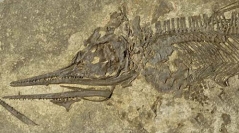

 Comptes Rendus Palevol
10 (5-6) - Pages 403-411
Comptes Rendus Palevol
10 (5-6) - Pages 403-411Here, we provide the first bone histological examination of an ontogenetic series of the basal ichthyosaur Mixosaurus encompassing postnatal to large adult specimens. Growth marks are present in sampled humeri, a femur, a fibula, as well as in other skeletal elements (gastral ribs). Ontogenetic changes are traceable throughout stylo- and zeugopodial development, but interior remodelling and resorption deleted part of the internal growth record in the primary cortex. Mixosaurus humeri started as flat structures consisting of a core of endochondral woven bone and residual calcified cartilage, whereas growth continued by deposition of periosteal fibrolamellar and parallel-fibred bone. Unlike the fast-growing post-Triassic ichthyosaurs that lack growth marks, microstructural and life history data are now becoming available for a basal ichthyosaur. The high growth rate of Mixosaurus may indicate that higher metabolic rates characterised small, non-thunniform ichthyosaurs, as had been suggested already for post-Triassic, cruising forms.
Ichthyopterygia, Mixosaur, Bone histology, Ontogenetic series, Monte San Giorgio, Microstructure